Analysis of Infection Transmission Routes through Exhaled Breath and Cough Particle Dispersion in a General Hospital
Abstract
:1. Introduction
2. Methods
2.1. Simulation Setup
2.2. Boundary Conditions for Breathing and Coughing Situations
3. Results and Discussions
3.1. Analysis of Breathing Particle Dispersion
3.2. Analysis of Cough Particle Dispersion
3.3. Comparison of Breath and Cough Particle Dispersion
4. Conclusions
Author Contributions
Funding
Conflicts of Interest
References
- WHO Coronavirus (COVID-19) Dashboard. Available online: https://covid19.who.int/ (accessed on 10 December 2021).
- Solis, J.; Franco-Paredes, C.; Henao-Martínez, A.F.; Krsak, M.; Zimmer, S.M. Structural Vulnerability in the U.S. Revealed in Three Waves of COVID-19. Am. J. Trop. Med. Hyg. 2020, 103, 25–27. [Google Scholar] [CrossRef] [PubMed]
- Sabel, C.E.; Pringle, D.; Schærström, A. Infectious Disease Diffusion. In A Companion to Health and Medical Geography; Brown, T., McLafferty, S., Moon, G., Eds.; Blackwell: Chichester, UK, 2010; pp. 111–132. [Google Scholar]
- Gupta, J.K.; Lin, C.-H.; Chen, Q. Flow dynamics and characterization of a cough. Indoor Air 2009, 19, 517–525. [Google Scholar] [CrossRef] [PubMed]
- Asadi, S.; Wexler, A.S.; Cappa, C.D.; Barreda, S.; Bouvier, N.M.; Ristenpart, W.D. Aerosol emission and superemission during human speech increase with voice loudness. Sci. Rep. 2019, 9, 2348. [Google Scholar] [CrossRef] [PubMed] [Green Version]
- Bake, B.; Larsson, P.; Ljungkvist, G.; Ljungström, E.; Olin, A.-C. Exhaled particles and small airways. Respir. Res. 2019, 20, 8. [Google Scholar] [CrossRef] [PubMed] [Green Version]
- Fabian, P.; Mcdevitt, J.J.; Dehaan, W.H.; Fung, R.O.P.; Cowling, B.J.; Chan, K.H.; Leung, G.M.; Milton, D.K. Influenza Virus in Human Exhaled Breath: An Observational Study. PLoS ONE 2008, 3, e2691. [Google Scholar] [CrossRef] [Green Version]
- Wan, G.H.; Wu, C.L.; Chen, Y.F.; Huang, S.H.; Wang, Y.L.; Chen, C.W. Particle Size Concentration Distribution and Influences on Exhaled Breath Particles in Mechanically Ventilated Patients. PLoS ONE 2014, 9, e87088. [Google Scholar] [CrossRef]
- Li, Y.; Huang, X.; Yu, I.T.; Wong, T.W.; Qian, H. Role of air distribution in SARS transmission during the largest nosocomial outbreak in Hong Kong. Indoor Air 2005, 15, 83–95. [Google Scholar] [CrossRef]
- Jo, S.; Hong, J.; Lee, S.-E.; Ki, M.; Choi, B.Y.; Sung, M. Airflow analysis of Pyeongtaek St Mary’s Hospital during hospitalization of the first Middle East respiratory syndrome patient in Korea. R. Soc. Open Sci. 2019, 6, 181164. [Google Scholar] [CrossRef] [Green Version]
- Ou, C.; Hu, S.; Luo, K.; Yang, H.; Hang, J.; Cheng, P.; Hai, Z.; Xiao, S.; Qian, H.; Xiao, S.; et al. Insufficient ventilation led to a probable long-range airborne transmission of SARS-CoV-2 on two buses. Build. Environ. 2022, 207, 108414. [Google Scholar] [CrossRef]
- Li, Y.; Qian, H.; Hang, J.; Chen, X.; Cheng, P.; Ling, H.; Wang, S.; Liang, P.; Li, J.; Xiao, S.; et al. Probable airborne transmission of SARS-CoV-2 in a poorly ventilated restaurant. Build. Environ. 2021, 196, 107788. [Google Scholar] [CrossRef]
- Li, X.; Shang, Y.; Yan, Y.; Yang, L.; Tu, J. Modelling of evaporation of cough droplets in inhomogneous humidity fields using the multi-component Eulerian-Lagrangian approach. Build. Environ. 2018, 128, 68–76. [Google Scholar] [CrossRef] [PubMed]
- Feng, Y.; Marchal, T.; Sperry, T.; Yi, H. Influence of wind and relative humidity on the social distancing effectiveness to prevent COVID-19 airborne transmission: A numerical study. J. Aerosol Sci. 2020, 147, 105585. [Google Scholar] [CrossRef] [PubMed]
- Yan, Y.; Li, X.; Tu, J. Thermal effect of human body on cough droplets evaporation and dispersion in an enclosed space. Build. Environ. 2019, 148, 96–106. [Google Scholar] [CrossRef] [PubMed]
- Mirzaie, M.; Lakzian, E.; Khan, A.; Warkiani, M.E.; Mahian, O.; Ahmadi, G. COVID-19 spread in a classroom equipped with partition—A CFD approach. J. Hazard. Mater. 2021, 420, 126587. [Google Scholar] [CrossRef] [PubMed]
- Zee, M.; Davis, A.C.; Clark, A.D.; Wu, T.; Jones, S.P.; Waite, L.L.; Cummins, J.J.; Olson, N.A. Computational fluid dynamics modeling of cough transport in an aircraft cabin. Sci. Rep. 2021, 11, 23329. [Google Scholar] [CrossRef]
- Zhou, Q.; Qian, H.; Liu, L. Numerical Investigation of Airborne Infection in Naturally Ventilated Hospital Wards with Central-Corridor Type. Indoor Built Environ. 2016, 27, 59–69. [Google Scholar] [CrossRef]
- Lu, Y.; Oladokun, M.; Lin, Z. Reducing the exposure risk in hospital wards by applying stratum ventilation system. Build. Environ. 2020, 183, 107204. [Google Scholar] [CrossRef]
- Tominaga, Y.; Mochida, A.; Yoshie, R.; Kataoka, H.; Nozu, T.; Masaru, Y.; Shirasawa, T. AIJ guidelines for practical applications of CFD to pedestrian wind environment around buildings. Wind. Eng. Ind. Aerodyn. 2008, 96, 1749–1761. [Google Scholar] [CrossRef]
- Sung, M.; Jo, S.; Lee, S.E.; Ki, M.; Choi, B.Y.; Hong, J. Airflow as a Possible Transmission Route of Middle East Respiratory Syndrome at an Initial Outbreak Hospital in Korea. Int. J. Environ. Res. Public Health 2018, 15, 2757. [Google Scholar] [CrossRef] [Green Version]
- Korean Law Information Center. Available online: https://www.law.go.kr/admRulLsInfoP.do?admRulSeq=2100000048049 (accessed on 10 December 2021).
- Gao, N.; Niu, J.; Morawska, L. Distribution of respiratory droplets in enclosed environments under different air distribution methods. Build. Simul. 2008, 1, 326–335. [Google Scholar] [CrossRef] [Green Version]
- Morawska, L.; Johnson, G.R.; Ristovski, Z.D.; Hargreaves, M.; Mengersen, K.; Corbett, S.; Chao, C.Y.H.; Li, Y.; Katoshevski, D. Size distribution and sites of origin of droplets expelled from the human respiratory tract during expiratory activities. J. Aerosol Sci. 2009, 40, 256–269. [Google Scholar] [CrossRef] [Green Version]
- Nicas, M.; Nazaroff, W.W.; Hubbard, A. Toward understanding the risk of secondary airborne infection: Emission of respirable pathogens. J. Occup. Enviorn. Hyg. 2005, 2, 143–154. [Google Scholar] [CrossRef] [PubMed]
- Wang, H.P.; Li, Z.B.; Zhang, X.L.; Zhu, L.X.; Liu, Y.; Wang, S.Z. The motion of respiratory droplets produced by coughing. Phys. Fluids 2020, 32, 125102. [Google Scholar] [CrossRef] [PubMed]
- Subramaniam, S. Lagrangian–Eulerian methods for multiphase flows. Prog. Energy Combust. Sci. 2013, 39, 215–245. [Google Scholar] [CrossRef] [Green Version]
- Li, H.; Leong, F.Y.; Xu, G.; Ge, Z.; Kang, C.W.; Lim, K.H. Dispersion of evaporating cough droplets in tropical outdoor environment. Phys. Fluids 2020, 32, 113301. [Google Scholar] [CrossRef] [PubMed]
- Bridgeman, O.C.; Aldrich, E.W. Vapor pressure tables for water. J. Heat Transf. 1964, 86, 279–286. [Google Scholar] [CrossRef]
- Ranz, W.E.; Marshell, W.R. Evaporation from drops, Part I. Chem. Eng. Prog. 1952, 48, 141–146. [Google Scholar]
- Kwon, S.-B.; Park, J.; Jang, J.; Cho, Y.; Park, D.-S.; Kim, C.; Bae, G.-N.; Jang, A. Study on the initial velocity distribution of exhaled air from coughing and speaking. Chemosphere 2012, 87, 1260–1264. [Google Scholar] [CrossRef]
- Tang, J.W.; Nicolle, A.; Pantelic, J.; Koh, G.C.; Wang, L.D.; Amin, M.; Klettner, C.A.; Cheong, D.K.W.; Sekhar, C.; Tham, K.W. Airflow Dynamics of Coughing in Healthy Human Volunteers by Shadowgraph Imaging: An Aid to Aerosol Infection Control. PLoS ONE 2012, 7, e34818. [Google Scholar] [CrossRef]
- Duguid, J.P. The size and the duration of air-carriage of respiratory droplets and droplet-nuclei. Epidemiol. Infect. 1946, 44, 471–479. [Google Scholar] [CrossRef] [Green Version]
- Villafruela, J.M.; Olmedo, I.; de Adana, M.R.; Méndez, C.; Nielsen, P.V. CFD analysis of the human exhalation flow using different boundary conditions and ventilation strategies. Build. Simul. 2013, 62, 191–200. [Google Scholar] [CrossRef]
- Fairchild, C.; Stampfer, J. Particle concentration in exhaled breath. Am. Ind. Hyg. Assoc. J. 1987, 48, 948–949. [Google Scholar] [CrossRef] [PubMed]
- Jiang, Y.; Zhao, B.; Li, X.; Yang, X.; Zhang, Z.; Zhang, Y. Investigating a safe ventilation rate for the prevention of indoor SARS transmission: An attempt based on a simulation approach. Build. Simul. 2009, 2, 281–289. [Google Scholar] [CrossRef] [PubMed]
- Meter, F.R.; Kuntz, M.; Langtry, R. Ten Years of Industrial Experience with the SST Turbulence Model. Turbul. Heat Mass Transf. 2003, 4, 625–632. [Google Scholar]
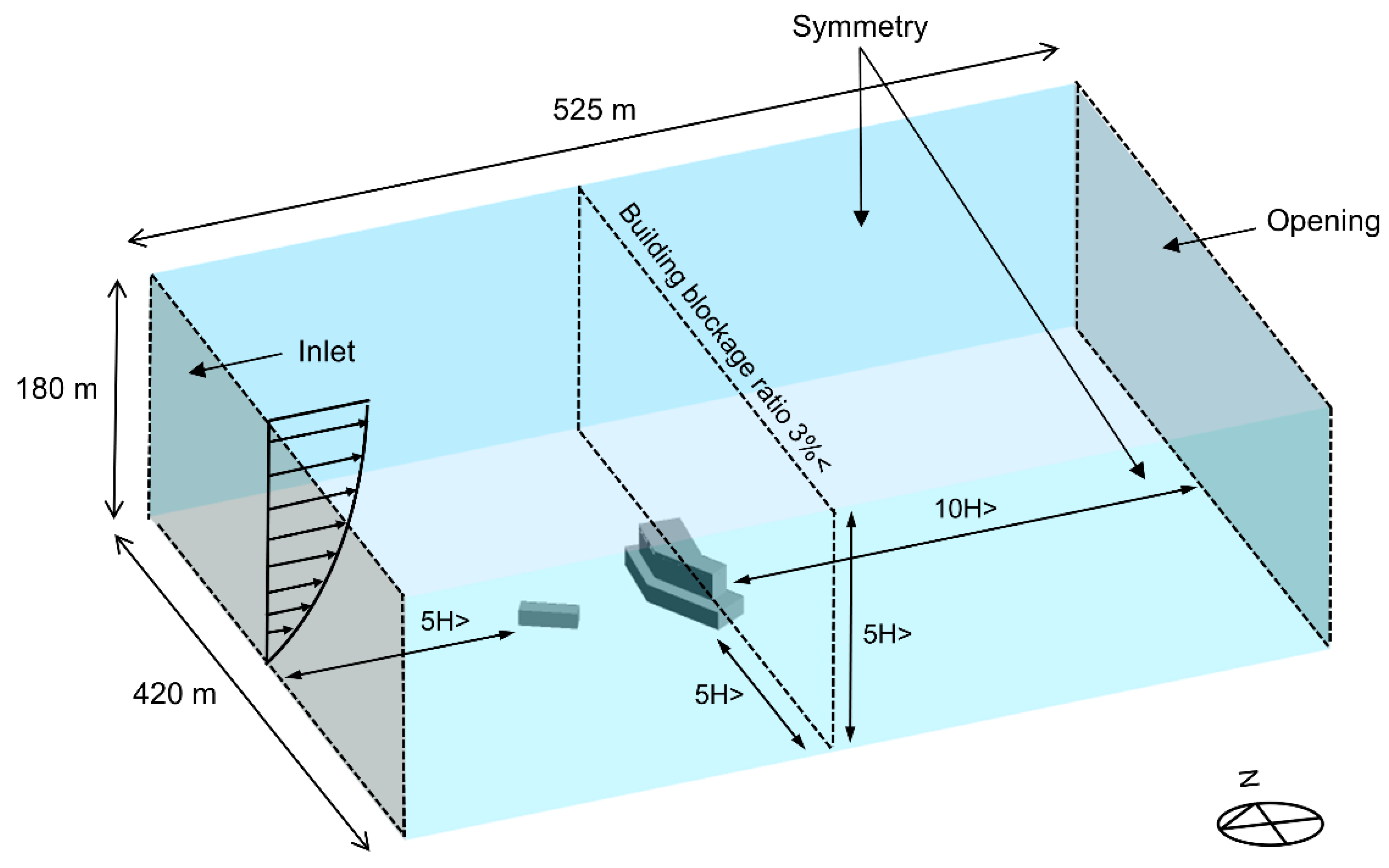
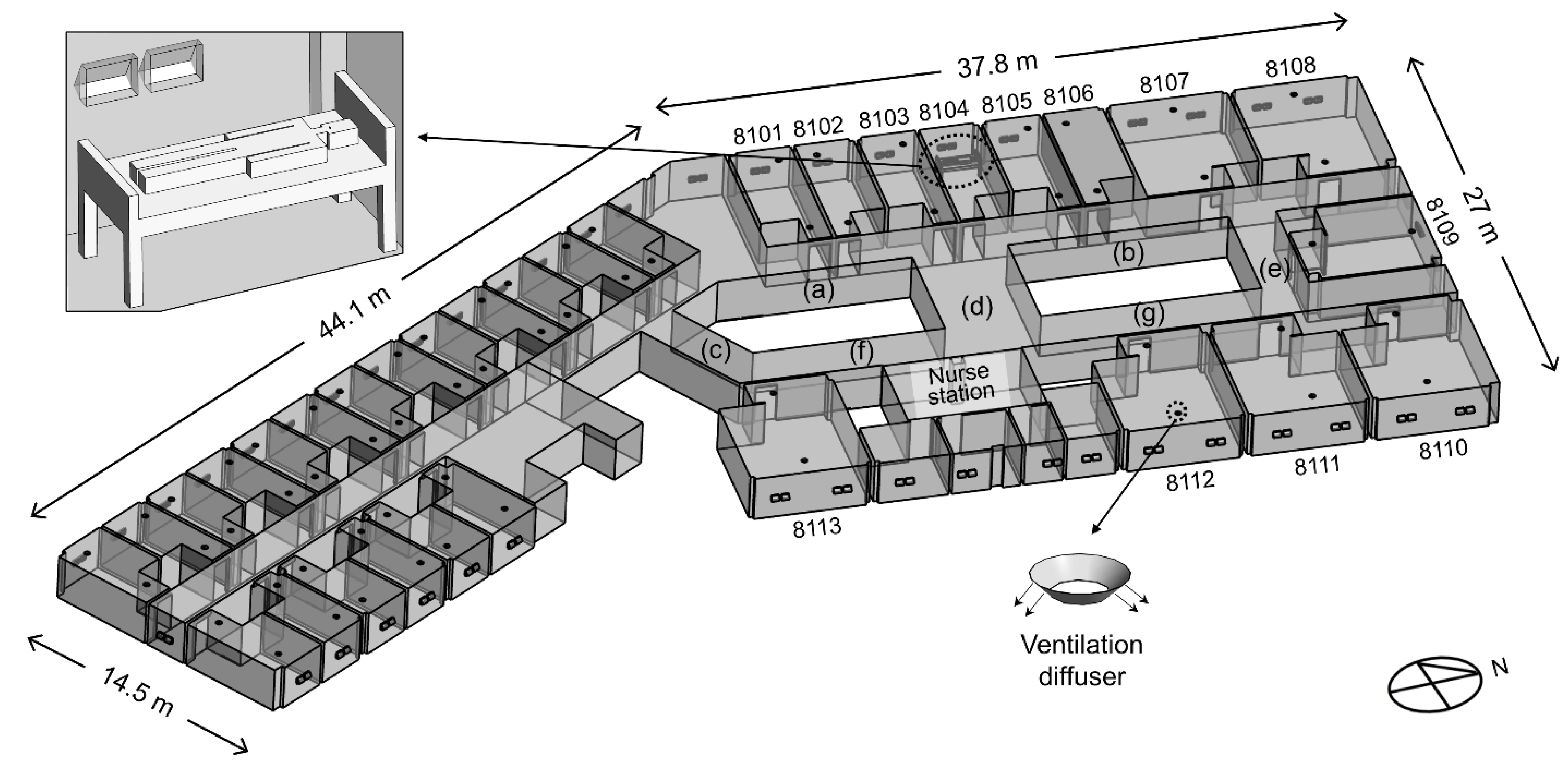
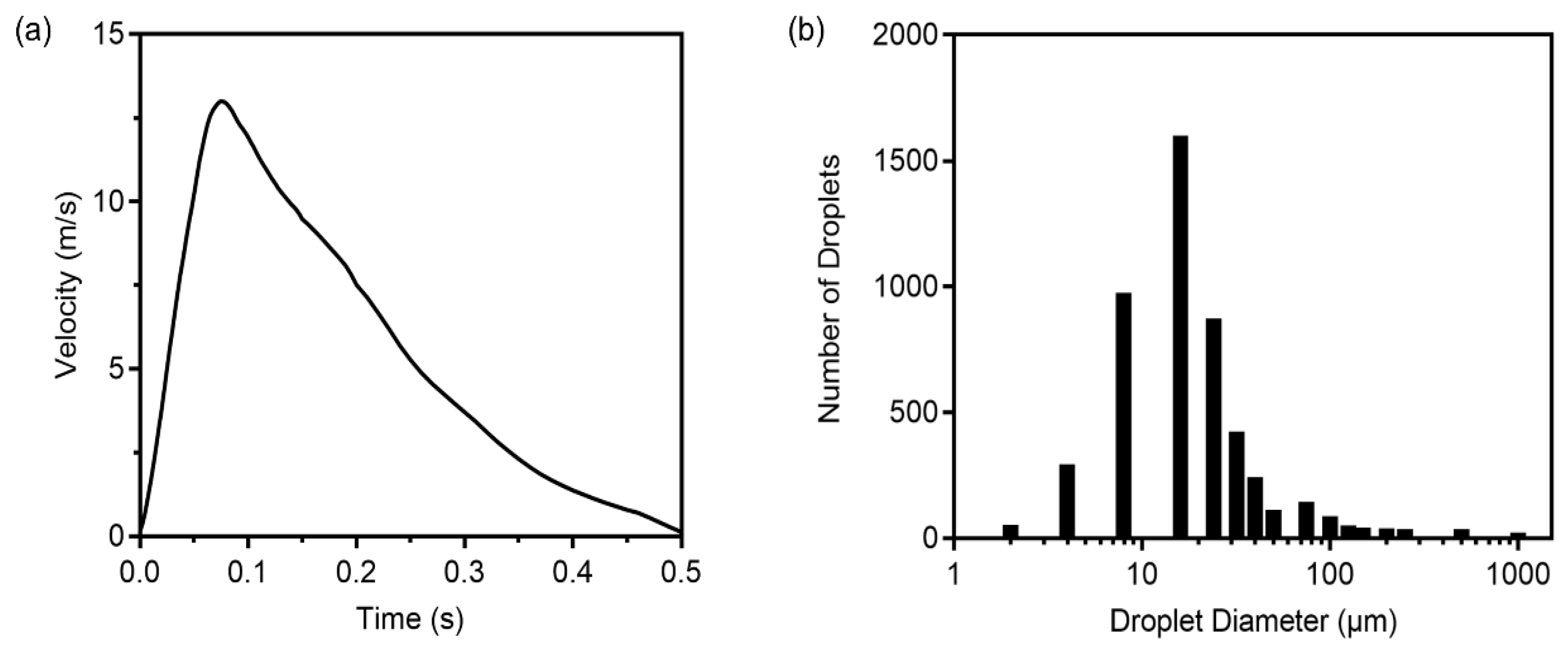
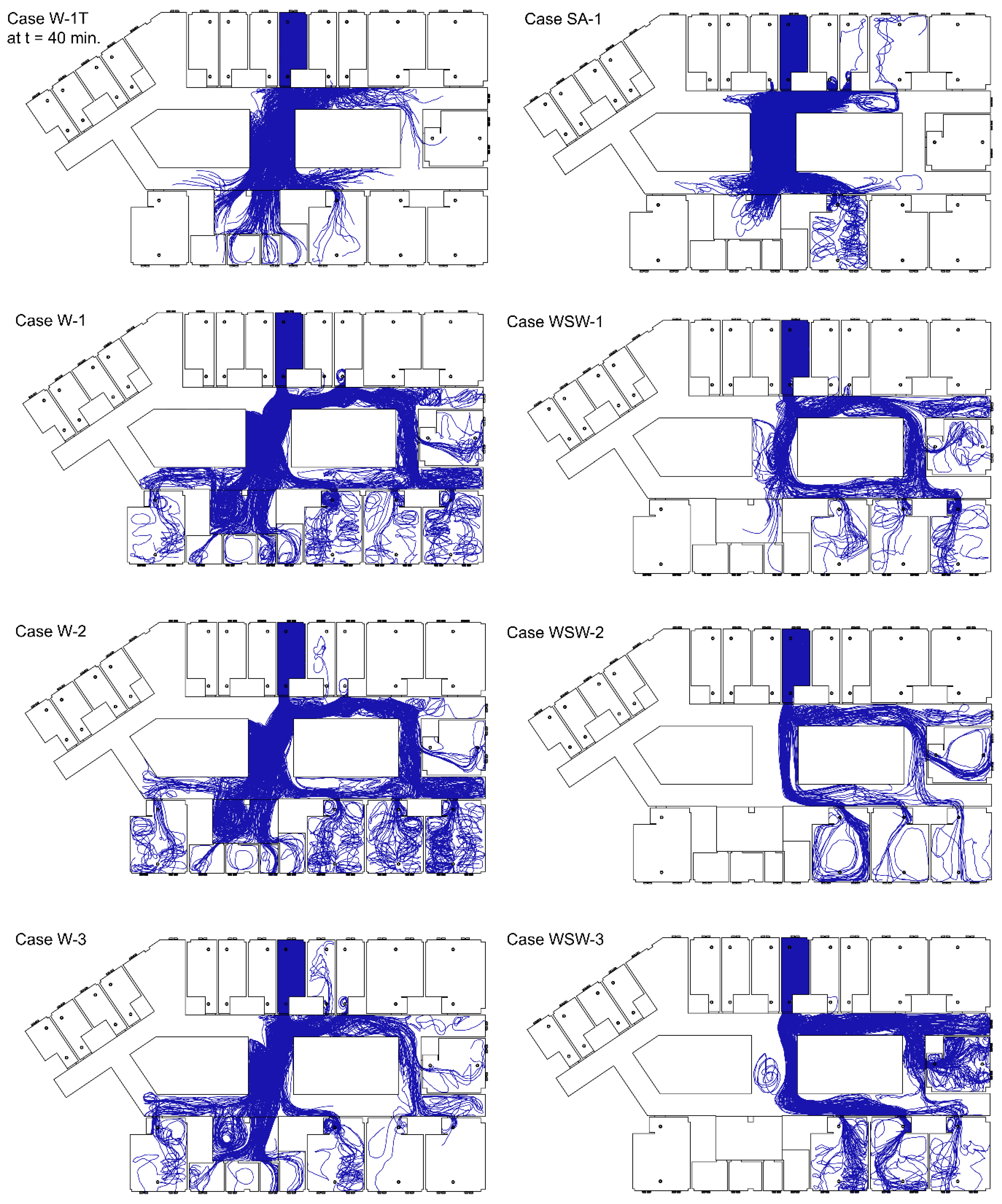
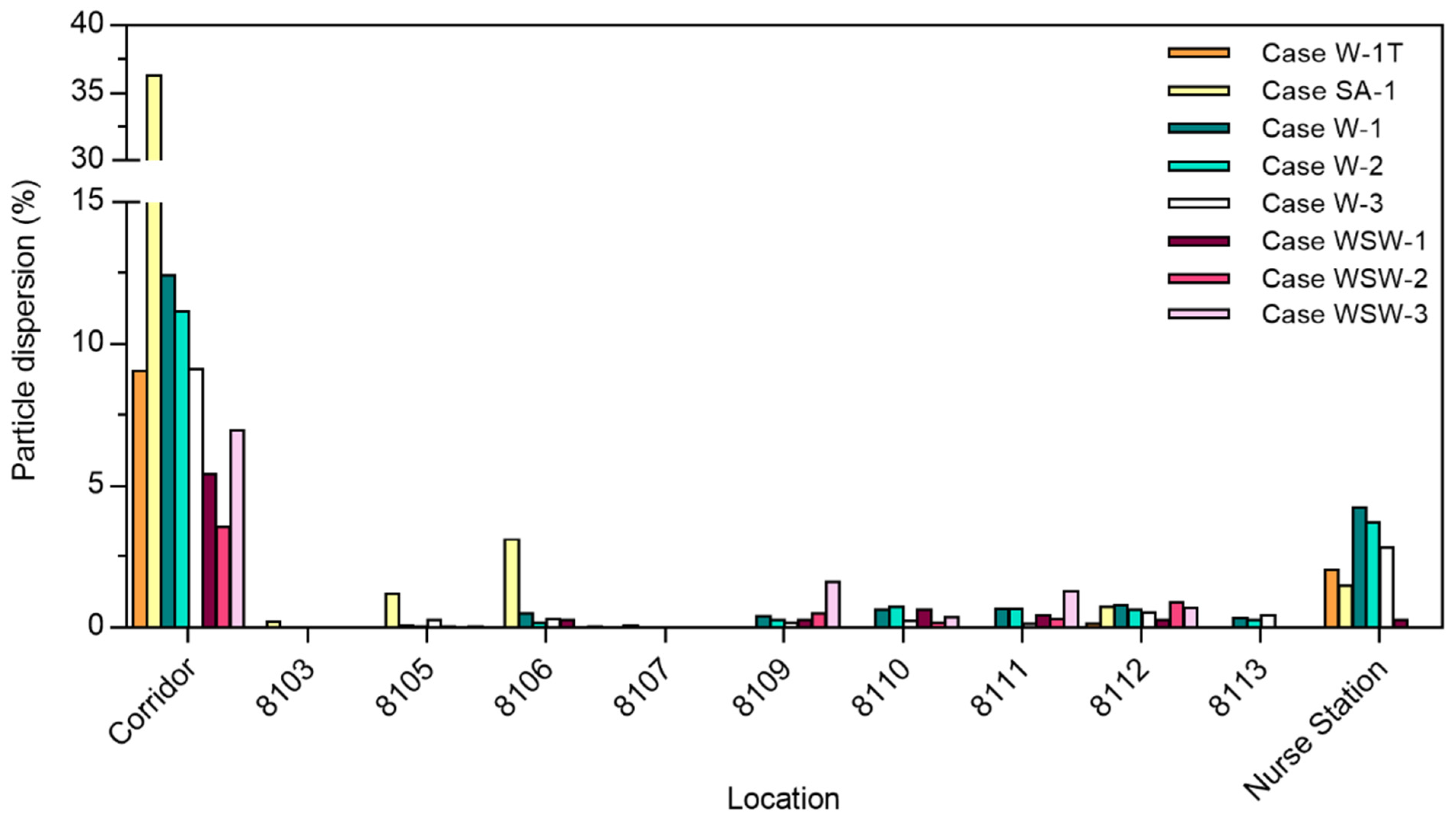




| Wind Direction | Mechanical Ventilation System | Respiration Event | Analysis Method | |
|---|---|---|---|---|
| Case SA-1 | Static air | Operated except in ward 8104 | Breathing | Steady-state |
| Case W-1T | West | Transient | ||
| Case W-1C | Coughing | |||
| Case W-1 | Breathing | Steady-state | ||
| Case W-2 | Not operated in all wards | |||
| Case W-3 | Operated in all wards | |||
| Case WSW-1C | West-southwest | Operated except in ward 8104 | Coughing | Transient |
| Case WSW-1 | Breathing | Steady-state | ||
| Case WSW-2 | Not operated in all wards | |||
| Case WSW-3 | Operated in all wards |
Publisher’s Note: MDPI stays neutral with regard to jurisdictional claims in published maps and institutional affiliations. |
© 2022 by the authors. Licensee MDPI, Basel, Switzerland. This article is an open access article distributed under the terms and conditions of the Creative Commons Attribution (CC BY) license (https://creativecommons.org/licenses/by/4.0/).
Share and Cite
Jung, M.; Chung, W.J.; Sung, M.; Jo, S.; Hong, J. Analysis of Infection Transmission Routes through Exhaled Breath and Cough Particle Dispersion in a General Hospital. Int. J. Environ. Res. Public Health 2022, 19, 2512. https://doi.org/10.3390/ijerph19052512
Jung M, Chung WJ, Sung M, Jo S, Hong J. Analysis of Infection Transmission Routes through Exhaled Breath and Cough Particle Dispersion in a General Hospital. International Journal of Environmental Research and Public Health. 2022; 19(5):2512. https://doi.org/10.3390/ijerph19052512
Chicago/Turabian StyleJung, Minji, Woong June Chung, Minki Sung, Seongmin Jo, and Jinkwan Hong. 2022. "Analysis of Infection Transmission Routes through Exhaled Breath and Cough Particle Dispersion in a General Hospital" International Journal of Environmental Research and Public Health 19, no. 5: 2512. https://doi.org/10.3390/ijerph19052512






